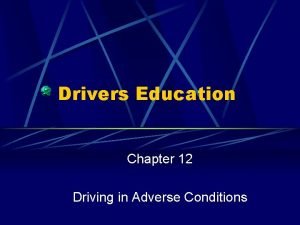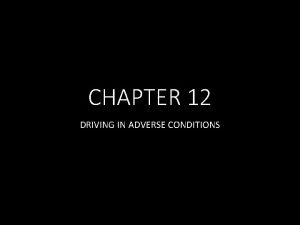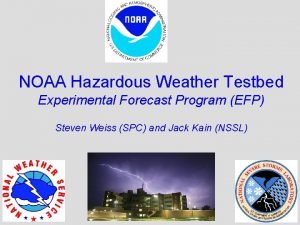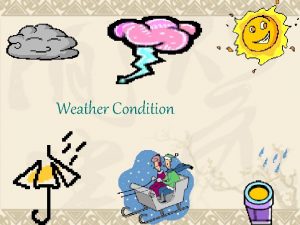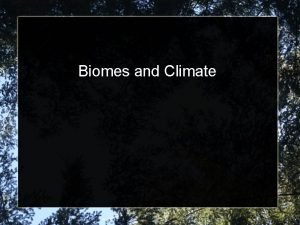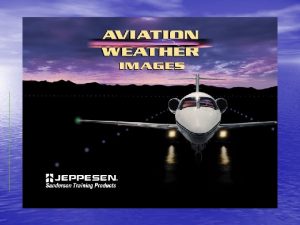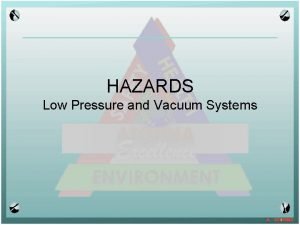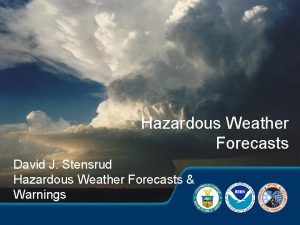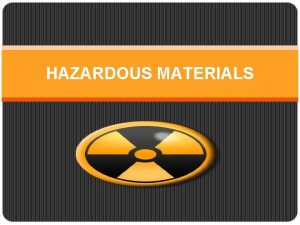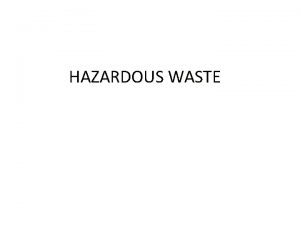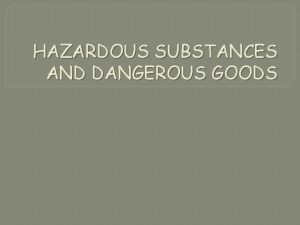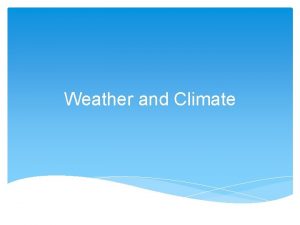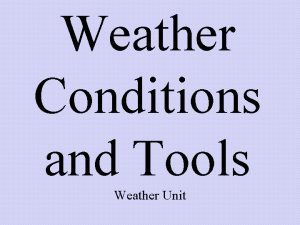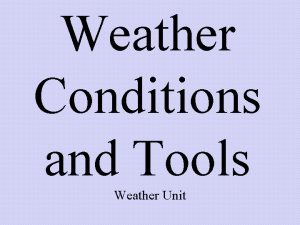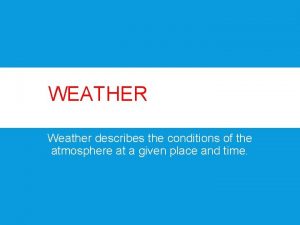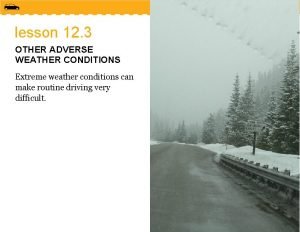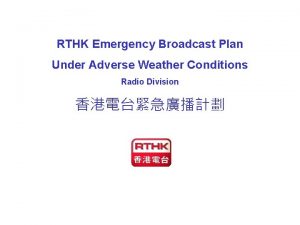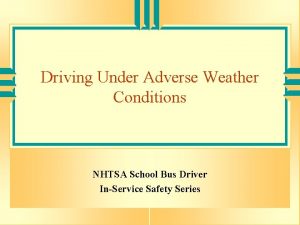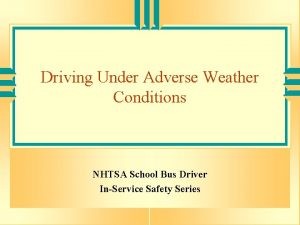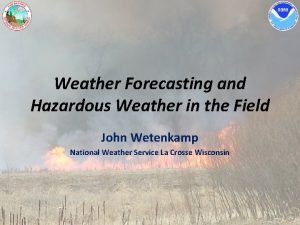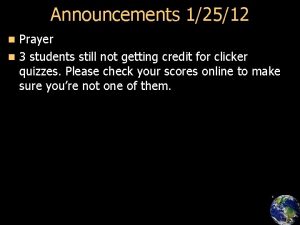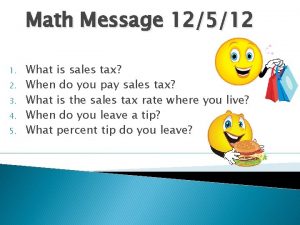12512 Adverse Weather Conditions WHAT ARE SOME HAZARDOUS


























- Slides: 26

1/25/12 Adverse Weather Conditions WHAT ARE SOME HAZARDOUS ROAD/ENVIRONMENTAL CONDITIONS THAT WOULD CAUSE YOU TO BE MORE CAUTIOUS BEHIND THE WHEEL?

Drivers Education CHAPTER 12 DRIVING IN ADVERSE CONDITIONS

Reduced Visibility Slow down and give yourself more time. Scan in and around your path of travel. Predict others will make maneuvers into your path of travel. Make maneuvers gently to maintain control so that others know what you are doing.

Your Vehicles Windows Keep them clean! If windows fog up Turn on front and rear defrosters. Use air conditioning/heater if it will help. Open window if needed.

Sun Glare At times the sun can create severe and blinding glare conditions. Sun visors can help, but avoid looking directly into the sun. Having headlights on can help other drivers see you. Be prepared for other divers not to see your signals.

Headlights Use high-beam lights to see further down the road. Only use high-beams when the vehicle in front of you is more than ½ mile ahead. Switch to low-beams the instant you see headlights of oncoming traffic. Switch to low-beams if a vehicle passes you. Use low-beam headlights in bad weather, highbeams will reflect the light back at you.

When should you use headlights? • Headlights must be turned on one half hour after sun set and one half hour before sunrise. • They must also be used when it is snowing, raining, and any precipitation that might be falling from the sky.

Meeting Other Vehicles If a driver fails to use lowbeams: Briefly flick your headlights to remind the driver to switch to lowbeams. Slow, and look to the right edge of the road and follow the white line. Look ahead with quick glances to check for traffic. Do not stare directly into high-beams.

Overdriving Headlights – means driving at a speed that makes your stopping distance longer than the distance lighted by your headlights.

Fog When your headlights shine into fog, light is reflected back by water particles. Always use low-beams. Fog can reduce ability to judge distance. Cars may be closer than you think. Thick fog can be very dangerous, you may want to pull over and park on the side of the road.

Rain Keep windshield clear by using wipers. If wipers are on your headlights must be on. If the rain is so heavy that you can not see, pull over and find a place to sit out the storm.

Snow can reduce vision, Fun in the snow Part 1 Fun in the snow Part 2 cover roadway markings, and make steering more difficult. Slush and snow can build on wipers. In blizzard conditions you do not want to be stranded in the middle of nowhere. If weather is bad, try to delay travel until road and weather improve.

Reduced Traction Hydroplaning – when tires contact with the road by rising up on the top of the water. Occurs about 35 mph in as little as 1/12 inch deep water. If you must go through standing water slow down below 35 mph. What to do if your vehicle hydroplanes

Reduced Traction Deep Water – when you don’t know how deep water is, don’t drive through it. If you must, try to estimate the depth. If there is any possibility it will reach the bottom of your car do not enter. Drive slow and ride the brake. Test brakes after you get through the puddle.

Snow The combination of snow, slushly water, and ice can make very slippery surfaces. Gentle acceleration, steering, and braking are the keys to driving in the snow. To improve traction you can put chains on your tires. (Nov. 15 -April 1) Rocking a Vehicle – can help move you out of deep snow, mud, or sand by moving forward and back.

Ice Be alert if temperatures are below freezing for ice. Squeeze brakes in icy areas to check traction. Ice on Bridges – bridges will freeze before other roadway surfaces. Black Ice – thin sheets of ice on the road surface that is hard to see.

Other Reduced Traction Situations Gravel Roads – loose gravel on roads can act like marbles under your tires and cause a skid. Leaves – wet leaves on the road can decrease traction and reduce you stopping and steering control. Construction Area – equipment can leave mud, dirt, and sand on the road.

Skidding Skid – when you tires lose their grip on the road. Skidding can happen during braking, accelerating, or steering. Early detection is the best defense to control skidding.

Skidding Over-Power Skid – this is when you apply to much power to the driver wheels. Over-Braking Skid – this is when you apply the brakes to hard and the car does not have ABS. Front –Wheel Skid – this is when you go into a turn and the front wheels want to say straight. Rear-Wheel Skid – this is when the rear wheels move right/left off target.

Avoiding Skidding Slow ahead of time before curves to avoid skids in curves. If you do skid in a curve you may skid of the road surface. Accelerate and brake gently. ABS will allow you to stop quickly and steering without skidding.

Controlled Braking – to reduce your speed as quickly as possible while maintaining steering control of you vehicle. Press the brake pedal will the ball of your foot hard enough to stop the vehicle quickly. If the wheels lock up, ease up on the brake pedal just enough for the wheels begin rolling again. Keep using the squeeze relax process until the vehicle stops.

ABS ABS(anti-lock braking system) – prevents wheels from locking up and skidding when stopping. You may feel a pulse when the ABS is working, but do not let up on the brake pedal. This will allow you to stop more quickly and steer while stopping.

Wind When strong wind is blowing, you may need to apply extra steering in the direction of the wind. You may experience this when drive out of a tunnel or over a bridge. The wind will move a large vehicle more than a smaller one.

Hot Weather Hot weather can cause your vehicle to overheat. Watch your temperature gauge to make your engine is not to hot. If engine is overheating, you can put the heat on or pull over and let the vehicle cool down. Never remove the radiator cap on a hot engine.

Cold Weather Be alert for exhaust leaks – make sure you have a source of fresh air coming into the vehicle. Do not race a cold engine – this will increase wear on the engine. Do not set your parking brake – ice or slush can freeze on your brake while the vehicle is parked.

Weather Driving Tips Look and listen for traffic reports. Keep you windows clear. Respect lower speeds. Keep a safe following distance. Try to keep moving in snow. Clear off snow from the hood, roof, and trunk.
 Mikael ferm
Mikael ferm Overdriving headlights means
Overdriving headlights means Overdriving headlights means
Overdriving headlights means Driving in adverse conditions
Driving in adverse conditions Driving in adverse conditions chapter 12
Driving in adverse conditions chapter 12 Hazardous weather testbed
Hazardous weather testbed Weather conditions name
Weather conditions name The average weather conditions of a place
The average weather conditions of a place Thunder is the sound of brainpop
Thunder is the sound of brainpop What receives the most solar radiation
What receives the most solar radiation Imc meteorological conditions
Imc meteorological conditions The weather conditions of a particular place
The weather conditions of a particular place Summer tongue twister
Summer tongue twister Capital weather gang weather wall
Capital weather gang weather wall It's windy and rainy
It's windy and rainy Poem of seasons
Poem of seasons Weather vs whether
Weather vs whether Station model symbol
Station model symbol Heavy weather by weather report
Heavy weather by weather report Some trust in chariots and some in horses song
Some trust in chariots and some in horses song What is contact force
What is contact force They say sometimes you win some
They say sometimes you win some Some say the world will end in fire some say in ice
Some say the world will end in fire some say in ice They say it only takes a little faith to move a mountain
They say it only takes a little faith to move a mountain Some say the world will end in fire some say in ice
Some say the world will end in fire some say in ice Ice cream countable
Ice cream countable Low pressure vacuum
Low pressure vacuum


